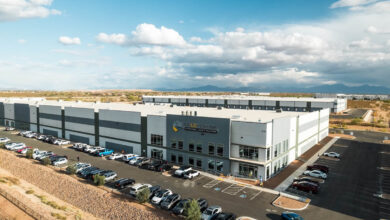
Mission Control: UArizona’s Applied Research Building Houses Space Institute, Future Endeavors
By Dave Perry
Erika Hamden, director of the UArizona Space Institute, can talk the science wherever she goes.
Hamden, associate professor in the Department of Astronomy and an assistant astronomer at UArizona’s foundational Steward Observatory, was at NASA headquarters in Washington D.C. not long ago.
Her mission in D.C. — to make sure “people know what we’re doing, and that they have the University of Arizona at the top of their minds when they’re thinking about initiatives, and missions they’d like to select.”
A NASA mission, the Pandora project, is about to become the first managed from inside the dedicated mission control center at UArizona’s new Applied Research Building, or ARB. Pandora intends to deploy an Earth-orbiting telescope to understand the atmospheric contents of “exoplanets,” planets circling distant stars, and the behavior of those host stars.
The project is coming to UArizona because “we have a really good facility and a really good price,” Hamden said. And, she adds, “the Space Institute, and the University of Arizona, are good at all space.”
In her role, Hamden is “helping to streamline the space mission proposal process, making sure we can bring space missions of various scales to the University of Arizona,” said Carmala “Carmie” Garzione, dean of the College of Science.
The UArizona Space Institute serves as an umbrella organization to facilitate the work of UArizona’s space-oriented researchers. It also operates the ARB, UArizona’s new, world-class test and integration center for satellites, spacecraft, and other tools of space.
The $85 million, 89,000-square-foot ARB provides “capabilities interesting to us, and to industry, too,” said Elliott Cheu, Ph.D., interim senior VP of research and innovation and associate VP for university research institutes.
Downstairs from the mission control center, researchers can replicate outer space’s extreme cold and pressure conditions by using the 40-ton thermal vacuum chamber, “the largest of its kind at a university.” It was purchased on eBay, Cheu said, smiling.
Or they can test high-altitude stratospheric balloons and nanosatellites known as CubeSats, build those toaster-sized CubeSats in a dedicated laboratory, test deep-space antennae in an echo- and bounce-free anechoic chamber, or use an imaging technology laboratory that positions UArizona as a world-leading supplier of advanced scientific imaging sensors for visible, ultraviolet and X-ray light detection.
There’s plenty more, and more to come. The ARB wants to bring in a “shaker table,” about 20-by-20 feet, so inquirers can “put your device on it, and simulate the conditions of lift-off,” Cheu said. “It would be the largest in the state of Arizona. There is a lot of interest from industry on that.”
UArizona wants to fill the ARB. Cheu knows early guests must say nice things.
“Success breeds success,” he said. “We want to have people have a good experience when they utilize these things. We want them to say, ‘it’s really easy to work with the University of Arizona’.”
PHOTO: Chris Richards, University of Arizona





